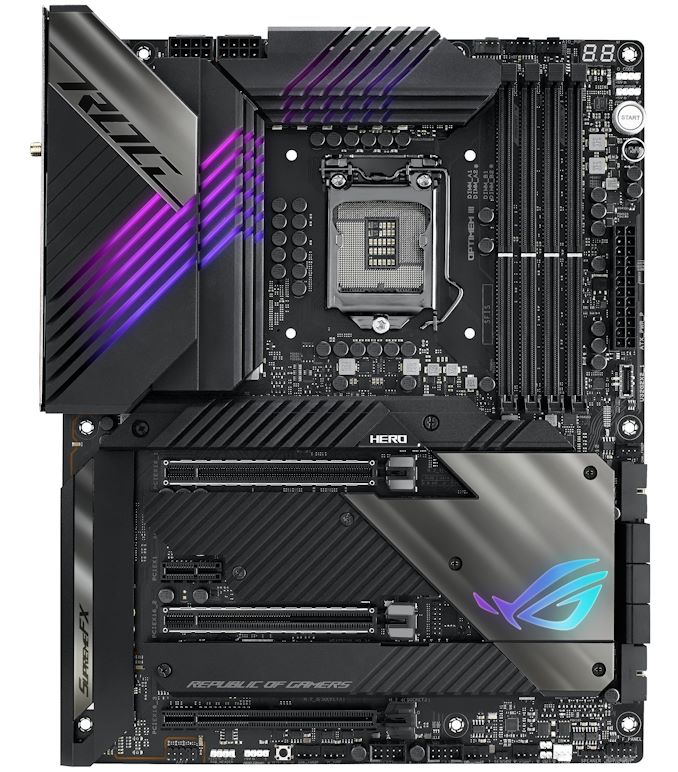The Intel Z590 Motherboard Overview: 50+ Motherboards Detailed
by Gavin Bonshor on January 19, 2021 10:15 AM ESTASUS ROG Maximus XIII Hero
Another model from ASUS's ROG Maximus line-up is the highly favorable Hero. The ROG Maximus XIII Hero offers Wi-Fi 6E, with dual 2.5 GbE and four PCIe M.2 slots. It uses a slightly different aesthetic compared with the previous Z490 Hero, with RGB LED lighting built into the rear panel cover and chipset heatsink. Still, ASUS's illustration leaves the question open whether or not the power delivery heatsink has them integrated too, which seems unlikely. The new Hero uses an ATX PCB, with a 14+2 power delivery with 90 A teamed power stages. Powering the CPU is a pair of 12 V ATX CPU power inputs.
The ASUS ROG Maximus XIII Hero includes a nice black and dark gray contrasting design, with three full-length PCIe slots. The top two operate at PCIe 4.0 x16 and x8/x8, while the bottom full-length slot is locked to PCIe 3.0 x4, and there is also one PCIe 3.0 x1 slot. The Hero includes six SATA ports with support for RAID 0, 1, 5, and 10 arrays, with four PCIe M.2 slots. Two of the M.2 slots operate at PCIe 4.0 x4, while the other two can support PCIe 3.0 x4 and SATA drives. In the top right-hand corner are four memory slots with support for up DDR4-5333, with a combined capacity of 128 GB. In the top right-hand corner of the board is a two-digit LED debugger, with a power on and rest switch pairing just below it.
On the rear panel is two Thunderbolt 4 Type-C, with six USB 3.2 G2 Type-A and two USB 2.0 ports. ASUS includes two RJ45 ports powered by two Intel I225-V 2.5 GbE controllers, with an Intel AX210 Wi-Fi 6E CNVi, which also includes support for BT 5.2 devices. For users planning to use Intel's integrated graphics, ASUS includes one HDMI video output. Regarding audio, ASUS is using a SupremeFX ALC404082 HD audio codec, with an ESS Sabre9018Q2C DAC. Finishing off the rear panel is a clear CMOS button and a BIOS Flashback button with a highlighted USB 2.0 port, which users can use to flash the board's firmware.
Typically bridging the gap between the ROG Maximus Extreme and Formula models to the Strix series, ASUS has set a price of $500. While this does seem on the high side of Z590 pricing, which we already know, ASUS does include a stacked rear panel including dual Thunderbolt 4 Type-C, dual 2.5 GbE, Wi-Fi 6E, as well as six USB 3.2 G2 Type-A.












88 Comments
View All Comments
lmcd - Tuesday, January 19, 2021 - link
8 cores is plenty for this generation of memory bandwidth. The problem is that Intel's next gen will have "16" processors where 8 are full cores, while AMD will have a full 16 cores with all that bandwidth. This generation, Intel is competitive but late.rahvin - Wednesday, January 20, 2021 - link
Is this an attempt to be funny?pman6 - Tuesday, January 19, 2021 - link
meh. show me the $80 b560 boards.this is overkill for me.
Geef - Wednesday, January 20, 2021 - link
Why is Intel always behind the game with memory speeds? 3200 is just a basic speed nowadays. Its great if your running CAS 14 chips but not many are. Why haven't they set a speed up to 4000 or 5000? They can keep XMP going just fine but wouldn't it be better to have systems automatically go that fast if they can?Deicidium369 - Wednesday, January 20, 2021 - link
JEDEC tops out at 3200 - the fastest OFFICIAL speed it 3200. I have Gskill DDR4 4133 on my Gigabyte Z390 / i9900Kand JEDEC speeds are the same for AMD and Intel
Duncan Macdonald - Wednesday, January 20, 2021 - link
For most games the 5800x is the sweet spot due to only having one CPU chiplet so no communication between chiplets. The 5900 and 5950 with two chiplets lose on many games due to the cost of inter chiplet communications exceeding the benefits from the extra cores.The 5900 and 5950 are best in programs that can make good use of all the cores (eg some video editing programs). For any game player with a 5900 or 5950, it might well be possible to get higher game performance by limiting Windows to only the first chiplet (using the numproc boot parameter).
Makaveli - Wednesday, January 20, 2021 - link
I agree with you however the 5800X is really overpriced right now. So when you only have to pay abit more for the 5900X its looks like a far better deal. I think once Rocket lake is out we should see a price correction on the 5800X so the time to buy those will be in March.yeeeeman - Wednesday, January 20, 2021 - link
This....this is wasted resources IMO. There was no need to make another platform on 14nm when they have the 10th gen which is just fine. I mean, the 10900k/10700k are great CPUs still, even compared to 5000 Ryzen series, so I don't know...they should've focused the efforts on bringing Alder Lake and its successor platforms forward.Hope Pat will make a bit of order here and make the schedules and ambitions of Intel a bit more daring, cause Bob just...milked it like there is no tomorrow. Refreshes after refreshes and refreshes.
Makaveli - Wednesday, January 20, 2021 - link
That's what happens when you have a finance guy running the company he is just going to keep the wheels turning and not be aggressive. The new guy is an engineer and I believe he will push the pace which is what Intel needs now.Oxford Guy - Thursday, January 21, 2021 - link
Well, the world really needed a stack of 15 boards from just one motherboard company, too.